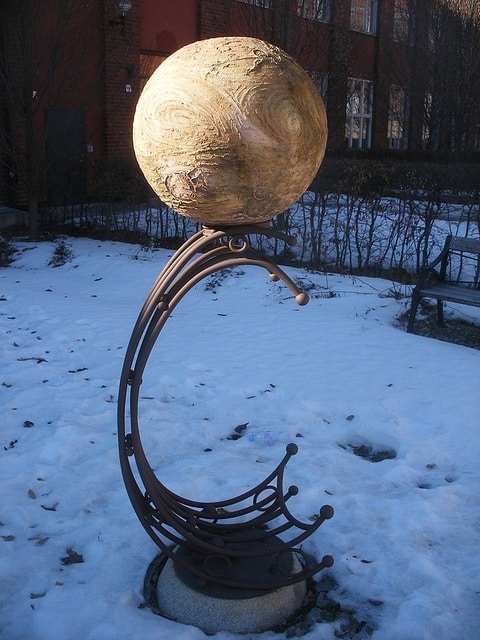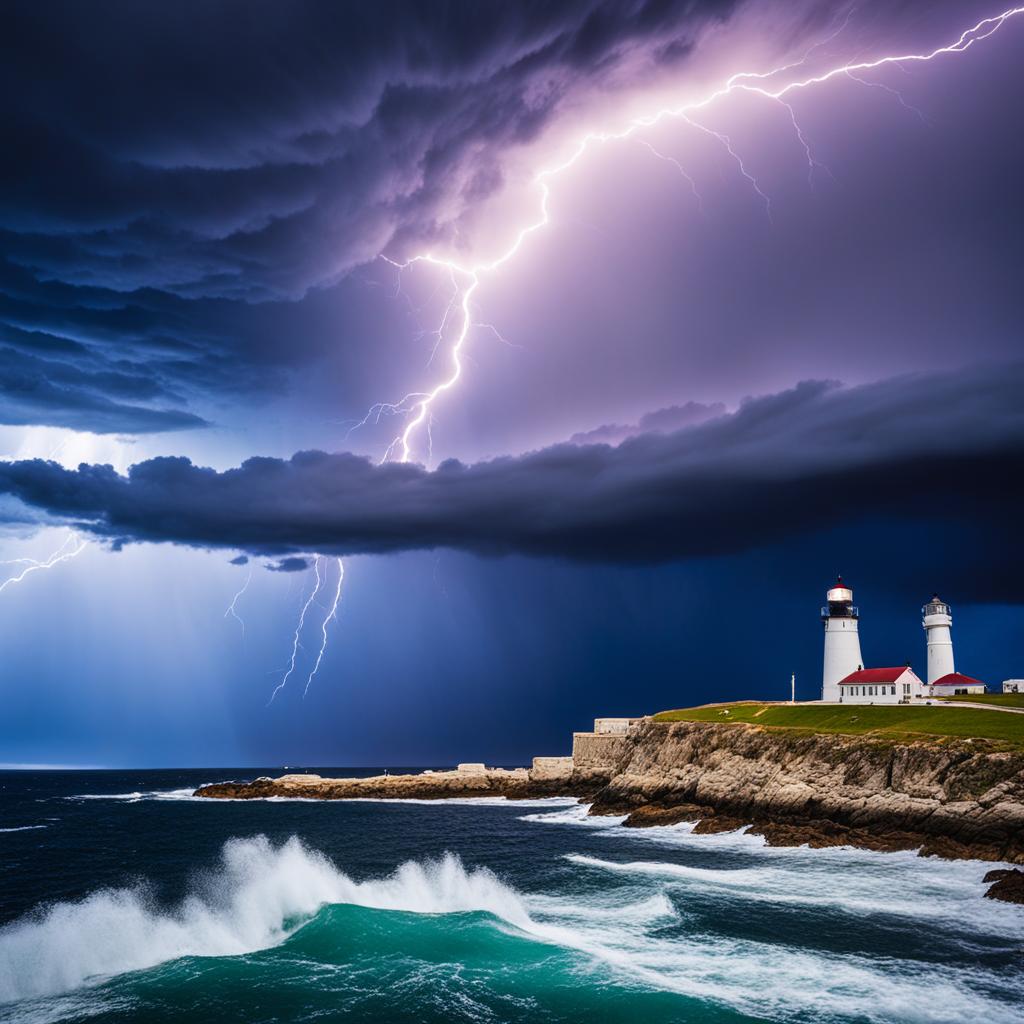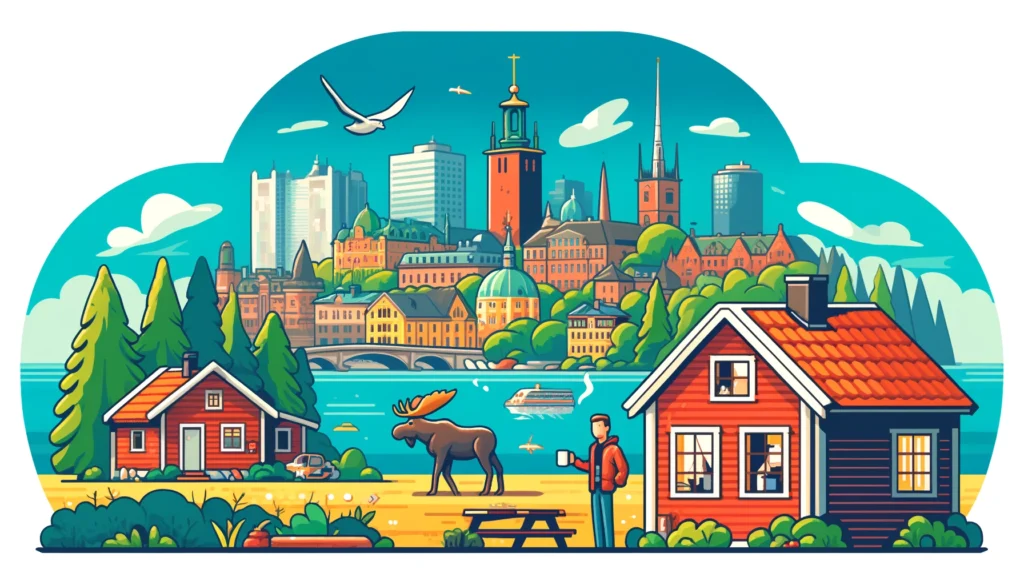As an avid traveller with a passion for science and astronomy, I’m always on the lookout for unique and educational attractions around the world. On a recent trip to Sweden, I discovered an epic scale model of the solar system spanning the entire country – the perfect destination for space lovers like myself!
Unbeknownst to most visitors, the country is home to the world’s largest permanent model of the planetary system known as The Swedish Solar System but often – as below – called Sweden Solar System, which is a bit odd if you ask me.

Okay, there’s a little artistic licence used here, I will admit!
Conceived by scientists Nils Brenning and Gösta Gahm and coordinated by the Swedish Astronomical Society, this intriguing project brings the vast distances of outer space down to an understandable scale here on Earth.
The models stretch across Sweden, creatively positioned at relevant locations and crafted with care using natural, local materials in many cases.
Image from Wikipedia commons (c) Einarspetz
The entire installation preserved distances and sizes on a scale of 1:20 million, making it the most extensive permanent solar system model globally. As an amateur astronomer, I was thrilled to explore the fascinating fusion of science, art, and mythology behind each planet. Here are the highlights from my journey through Sweden’s celestial celebrations.
The Swedish Solar System: Key Takeaways
After exploring Sweden’s grand solar system model from end to end, here are some key takeaways:
- At a 1:20 million ratio, it’s the world’s largest permanent model of the planetary system
- Creative installations merge science, art, culture, and mythology for each planet
- Local materials used for exhibition stops nationwide, like copper for Venus or dellenite meteorite for Pluto
- Inner planets clustered around Stockholm, outer planets spread across Sweden
- Ongoing expansion planned with new additions like replacement Uranus sculpture
- Provides visual understanding of enormous real distances between planets
- Combines education for all ages with sense of adventure across Sweden
The Sun: Avicii Arena, Stockholm
Image obtained from Flickr.com under Creative Commons (c) Joongi Kim
No solar system tour could start anywhere but the Sun! Fittingly, Stockholm’s iconic Avicii Arena (also known as Globen) represents the centre of our solar system. As the world’s largest spherical building, the arena’s 110-metre diameter and 85-metre height approximates the Sun itself. While even this massive structure cannot capture the true scale of our stellar anchor, it ignites the imagination.
Exhibits at the arena provide an overview of the Sun’s key facts and characteristics. Visitors can marvel at its sheer size and learn about phenomena like sunspots, solar flares, and coronal mass ejections that impact our solar system. Beyond the science, presentations also cover the Sun’s mythological and cultural significance across ancient civilizations.
Mercury: Stockholm City Museum
Image obtained from Flickr.com under Creative Commons (c) Riviera Kid
After marvelling at the star of the show, I headed 3 km to the Stockholm City Museum to visit quicksilver Mercury. As the innermost planet at just 25 cm across, frequent heating reminds visitors of its extreme proximity to the Sun. Exhibits outline details like its small size, sparse atmosphere, and extreme temperatures ranging from -170°C to 427°C.
Being so close to the Sun, Mercury zips around its orbit in just 88 days. Early astronomers named it after the Roman messenger god known for his speed and mobility. The museum links Mercury’s attributes to themes of communication, trade, and travel.
By the way, there is so much to see in the city that I wrote this must-do guide to Stockholm to inspire you.
Venus: KTH Royal Institute of Technology
Image obtained from Flickr.com under Creative Commons (c) Anders Sandberg
My journey across Sweden’s celestial trail continued 5.5 km away to the Royal Institute of Technology (KTH). Here I explored their 62 cm sculpture of Earth’s mysterious sibling, Venus. Crafted by artist Daniel Oberti and unveiled in 2004, the copper model evokes the planet’s luminous cloud cover. Fun fact – Venus rotates backwards compared to other planets!
KTH’s exhibits provide an overview of Venus as the hottest planet in our solar system with an average surface temperature of 462°C. Sulphuric acid clouds perpetually shroud the surface, creating a powerful greenhouse effect. The presentations also highlight Venus’ associations with beauty and love in Roman mythology.
Earth and Moon: Swedish Museum of Natural History
What project modelling our cosmic neighbourhood would be complete without Earth? Situated 7.6 km from our first stop, the Swedish Museum of Natural History appropriately hosts scaled spheres representing Earth (65 cm diameter) and its loyal lunar companion (17 cm across).
In the museum’s Cosmonova hall, eye-popping 3D films provide sweeping tours of Earth’s geographical features and highlight critical issues like climate change. Additional exhibits showcase the diversity of life found on our planet through time. From majestic blue whales to fantastic feathered dinosaurs, it’s a humbling experience.
The Moon display recaps its cosmic origins, cratered terrain, and how its gravitational influence creates tides on Earth. Young visitors can get hands-on with lunar samples, learning about its composition and structure first-hand.
Mars: Mörby Centrum
Image (c) mirasmirakel.blogspot
Earth’s nextdoor neighbour Mars has captured public imagination recently, with NASA rovers like Curiosity revealing tantalizing details about the Red Planet’s environment and history. Luckily, I didn’t have to travel 140 million miles to visit Mars – just 11.6 km from the city centre to Stockholm’s Mörby Centrum shopping mall.
Created by Finnish sculptor Heikki Haapanen, the mall’s 35 cm Mars sphere is appropriately built from copper, oxidized to an otherworldly red hue. Fun fact – Mars’ distinctive colour comes from large amounts of iron oxide (rust) coating its surface!mall’s 35 cm Mars sphere
Exhibits provide an overview of Mars’ size, structure, and significant features like Olympus Mons, the largest volcano in our solar system. Set up in the shopping mall, the model also explores Mars’ influence on popular culture, from H.G. Wells’ ‘War of the Worlds’ to Elton John’s ‘Rocket Man’.
Jupiter: Stockholm Arlanda Airport
All the planets I’d seen so far paled next to the king of our solar system – mighty Jupiter! The largest planet, Jupiter’s immense scale is honoured with a 7.3 metre diameter floral arrangement at Stockholm’s Arlanda Airport.
Set 42 km from Stockholm’s centre, the airport is Sweden’s largest, making it the natural home for the giant of our cosmic family. While not as exciting as a planetary sphere, the vivid Jupiter-themed flowerbed illustrates the gas giant’s swirling cloud bands and gigantic presence.
Exhibits share fascinating facts about Jupiter’s composition, storms like the Great Red Spot, its 79 moons, and its central role in protecting the inner solar system from asteroid impacts. Who knew airports could make such great planetariums?
Saturn: Anders Celsius Observatory, Uppsala
Jumping on a quick flight brought me to Uppsala, 76 km north of Stockholm. Home to the venerable Anders Celsius Observatory at Uppsala University, founded in 1741, this city provides the backdrop for the next stop on my space voyage: ringed beauty Saturn.
The observatory’s model imaginatively represents the stunning Saturnian ring system as a suspended metallic hoop, 6.1 metres across. Saturn itself has a diameter ten times that of Earth, though one could never tell from the observatory’s version crafted to the grand 1:20 million scale.
Exhibits outline our understanding of Saturn’s extensive ring structure, its many moons like frozen Titan, as well as its composition and intriguing hexagonal polar vortex. An immersive experience for both kids and adults!
Uranus and Neptune: Ice Giants
Sadly, the model for Uranus was damaged by vandals. The original Uranus sculpture in Gävle was replaced by a new one ( 2.6 metres) of the ice giant which was installed in 2012 near Stora Magasinet in Lövstabruk, 124 kilometres from Avicii.
Image from Wikipedia under Creative Commons (c) Vincnetas
Neptune’s 2.5 metre glowing orb is best viewed after dark in the village of Söderhamn, 229 km from Stockholm.
Exhibits elaborate on the ice giant nature of Uranus and Neptune, the ring systems, bizarre rotations, powerful winds, and striking blue hues. Uranus’ off-kilter spin makes it appear to roll around the Sun! Neptune’s vivid cyan colour comes from atmospheric methane. These frozen, far-flung worlds demonstrate the solar system’s incredible diversity.
Pluto: Delsbo
Formerly considered our 9th planet, beloved Pluto was reclassified as a dwarf planet in 2006. But it still maintains a special spot in many space enthusiasts’ hearts! The model in Delsbo captures Pluto and its largest moon Charon, orbiting a central pillar 300 km from Stockholm.
At just 12 cm for Pluto and 4 cm for Charon, it takes creative vision to appreciate these distant mini-worlds. Exhibits chronicle Pluto’s demotion from planet to dwarf planet, its elliptical 248-year orbit, and its composition of frozen nitrogen, methane, and carbon monoxide ices.
The dwarf planet and moon pair orbit a unique sculpture created using dellenite – a greenish meteorite mineral only found in Sweden. It symbolizes Pluto’s role as the Roman god of the underworld.
The Edge of the Solar System
No model of our cosmic neighbourhood would be complete without defining its boundaries. The final stop on my Swedish solar system journey was Kiruna, 145 km north of the Arctic Circle. Home to the Swedish Institute of Space Physics, this is where our Sun’s influence finally peters out.
The solar wind of charged particles blown out by the Sun slows down and mingles with interstellar space at Here is the continuation of the expanded and updated article on the Swedish Solar System model:
The Edge of the Solar System
No model of our cosmic neighbourhood would be complete without defining its boundaries. The final stop on my Swedish solar system journey was Kiruna, 145 km north of the Arctic Circle. Home to the Swedish Institute of Space Physics, this is where our Sun’s influence finally peters out.
The solar wind of charged particles blown out by the Sun slows down and mingles with interstellar space at the edge of the heliosphere – the aptly named Termination Shock. While no permanent exhibition currently exists in Kiruna, the Institute has set aside space for a future installation to mark this distant limit nearly 950 km from Stockholm.
Standing at this symbolic boundary, looking back across Sweden from end to end, I was able to grasp the tremendous scale of our solar system in a way no textbook diagram could match. This epic concrete model – blending art, science, and adventure – brings the mysteries of space down to Earth for all to enjoy.
Reflecting on Sweden’s Celestial Wonders
After travelling across Sweden from the Sun to the edge of interstellar space, I was struck by the creativity and ingenuity behind this educational project. The solar system is displayed in a fresh, engaging way that sticks with you long after visiting.
Beyond being eye-opening and fun, the exhibition also emphasizes important lessons. The sheer empty distances separating even our closest cosmic neighbours are humbling. Each world in our solar system tells its own unique story of creation and evolution. I’ve gained a renewed appreciation for planet Earth as an almost impossibly rare, vibrant oasis.









[…] – http://www.astro.su.se/english/about-us/sweden-solar-system-directions-and-map-1.74662 – https://grownuptravelguide.com/the-swedish-solar-system […]